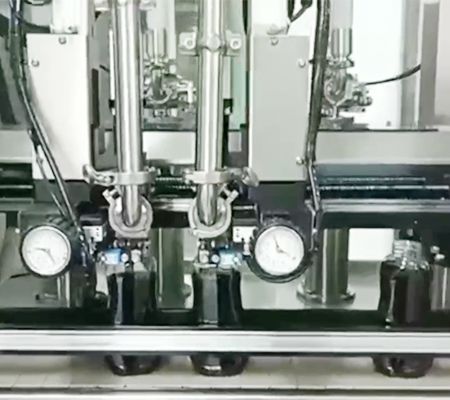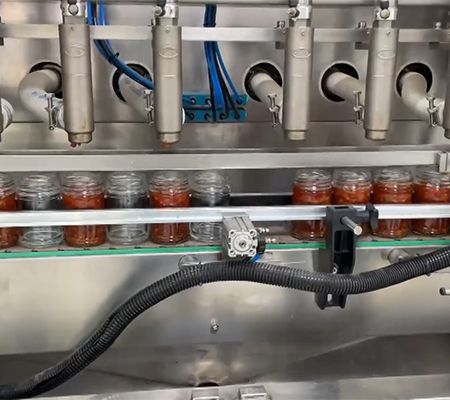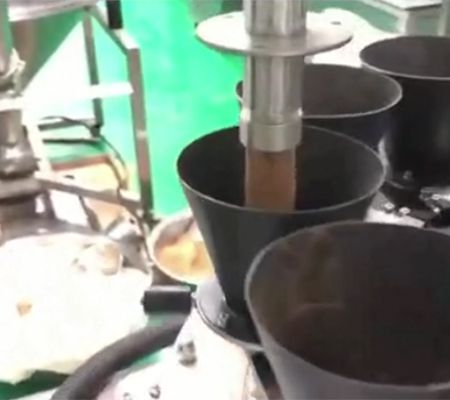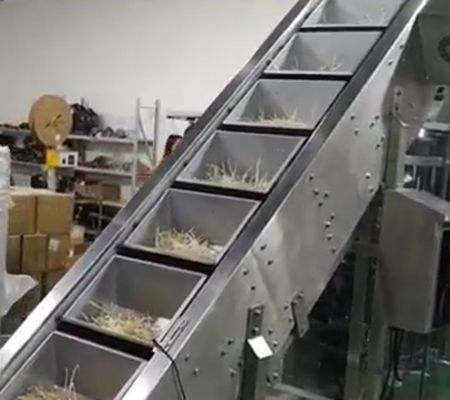What is bottle unscrambler machine?
As a part of the bottle filling lines, bottle unscrambler machines mainly sort, orient and feed bottles of various shapes and sizes.
Which types of bottles can be processed by a bottle unscrambler machine?
The bottle unscrambler is engineered to handle a wide range of bottle types, including round, rectangular, square, and oval shapes, constructed from either plastic or glass.
Advantages of Bottle Unscrambler Machines
The bottle unscrambler machine can seamlessly integrate with existing production, filling, or packaging lines. It is adept at sorting and orienting a broad spectrum of plastic and glass bottles. This versatility makes it an ideal solution for industries such as food processing, beverage filling, and pharmaceutical packaging and filling.
What are the factors I should consider when choosing a bottle unscrambler machine?
- Speed Compatibility: The unscrambler's speed must match the pace of your production line to ensure a seamless flow.
- Hopper Size: Choose a hopper size that can adequately accommodate your containers, avoiding bottlenecks or inefficiencies.
- Container Compatibility: Ensure the machine is designed to handle the specific style and dimensions of your containers.
- Integration and Space: The machine should integrate easily with your existing production lines and fit within the available space for installation.
What types of containers are bottle rinsing machines primarily applied to?
Bottle rinsing machines are primarily used in packaging and filling lines for the cleaning of a variety of containers including plastic bottles, glass bottles, metal cans, and other types of containers.
Which contaminants are targeted by bottle rinsing machines?
They are designed to eliminate contaminants such as dust, particles, and grease that may accumulate on bottles during transportation and handling processes.
Are bottle rinsing machines adaptable to various sizes and shapes of bottles?
Yes, the design flexibility of our bottle rinsing machines allows them to accommodate a wide array of bottle sizes and shapes, demonstrating high adaptability within the bottle filling line.
Can bottle rinsing machines be integrated into existing bottle filling lines?
Yes, we provide a diverse range of bottle rinsing machines that can be customized to suit your production line needs. Whether you opt for standard or custom bottle rinser, they are engineered for easy integration into your bottling line.
What is a capping machine and what is it used for?
Capping machines are pivotal in various industries for attaching or securing caps, lids, or closures to bottles or containers. They are versatile and can be tailored for numerous applications, including general packaging, industrial use, food and beverage processing, agriculture, chemical, and cosmetic industries.
Can a capping machine accommodate all types of bottles and caps?
A capping machine is designed to handle specific types of caps and bottles. Once configured for a particular packaging line, it can efficiently manage caps and bottles within the predetermined size range, provided they adhere to the type of capping it is designed for.
What are the common types of capping machines?
Depending on the efficiency requirements of the filling line, the available capping machines include automatic, manual, and semi-automatic models, each designed to meet different operational needs.
What features should be considered when selecting a capping machine?
When choosing a capping machine, important considerations include the production line's filling speed, ease of use, compatibility with the bottle and cap sizes, and the machine's maintainability and durability to ensure long-term operational efficiency.
What is a labeling machine used for?
Labeling machines are used in filling lines to apply labels and decorative features to various types containers, such as bottles, jars, and tubes. These machines are designed to enhance efficiency and accuracy in labeling processes without the need to increase labor costs, offering a more precise alternative to manual labeling.
What are the different types of labeling machines available?
There are various types of labeling machines tailored for specific requirements in filling lines, including:
- Manual labeling machines: Best suited for low-volume operations.
- Semi-automatic labeling machines: Versatile equipment that significantly boosts labeling efficiency.
- Automatic labeling machines: Designed for high-demand labeling tasks with capabilities for automatic adjustments.
- In-line labeling machines: These machines are designed to integrate easily into existing production and packaging lines, enhancing workflow efficiency
What labeling methods are supported by labeling machines?
Labeling machines support various techniques to cater to the specific needs of different packaging lines, including:
- Wrap-around labeling for cylindrical containers.
- Top and bottom labeling for comprehensive coverage.
- Front and back labeling for full product detailing.
- C-wrap or clamshell labeling for unique packaging styles.
- Band or strap labeling for specialized product applications.
What is a filling machine?
Filling machines are pivotal equipment across many industries, including food and beverage, pharmaceuticals, and cosmetics. These machines ensure high precision and flexibility in operations, accurately measuring and dispensing bulk items into containers efficiently.
What are the various types of filling machines available?
There is a broad array of filling machines tailored to meet different needs, such as manual, semi-automatic, and automatic liquid filling machines, rotary fillers, piston fillers, and in-line liquid filling machines, each designed for specific applications and operational scales.
What types of liquids can be handled by a liquid filling machine?
Liquid filling machines are versatile, capable of handling a wide range of products. Common applications include filling water, oils, alcoholic beverages, syrups, creams, and more, catering to the specific needs of various industries.
What materials can powder and granule filling equipment manage?
Powder filling machines are integral to the food processing, cosmetics, and pharmaceutical industries, offering precise weighing and filling solutions for products like sugar, coffee, pharmaceuticals, and other powdered or granulated materials.
Which products are paste filling machine suited for?
Paste filling machines are specially designed for high-viscosity products and are widely used in the cosmetics and household products sectors. These machines are ideal for filling creams, emulsions, shampoos, automotive waxes, and similar viscous materials, ensuring efficient and consistent product handling.
What is a shrink sleeve labeling machine?
Shrink sleeve labeling machines are devices used in packaging and bottle filling lines to apply shrink sleeve labels to containers. They are extensively applied across various industries, including food and beverage, personal care, cosmetics, and more.
What functions does a shrink sleeve labeling machine serve?
Shrink sleeve labeling machines play a crucial role in the food processing, beverage, and pharmaceutical industries by providing anti-tampering measures, ensuring compliance with regulatory standards, facilitating brand identification, serving as an advertising medium, and enabling multi-piece packaging.
What types of products are suitable for shrink sleeve labeling machines?
Shrink sleeving machines are adaptable and can be integrated into existing filling and packaging lines to sleeve a wide range of containers. These include packaging for beverages, food items, dairy products, wines, spirits, pharmaceuticals, and more.
Which parts of a product can be sleeved and labeled with a shrink sleeve labeling machine?
The application of shrink sleeves can be customized according to customers' requirements. Common sleeving positions include the top (finish sleeve), the main body of the bottle (body sleeve), or the base of the container (base sleeve).
Challenges in Wine Bottling
The wine bottling process face challenges such as preserving the wine's integrity throughout the bottling phase, accommodating a diverse array of glass bottle types and sizes, and achieving efficient filling processes without compromising the wine's quality.
Solutions for Wine Bottling
To address these challenges, gravity filling methods are employed to ensure high-quality filling, versatility, and efficiency. Additionally, customization options are available to cater to varying container types and sizes, ensuring a desired bottling operation.
Benefits of Gravity Filling Technology in Wine Bottling
Gravity filling leverages the natural flow properties of wine, integrating inert gas technology to preserve the wine's essential characteristics, such as flavor, aroma, and mouthfeel, effectively maintaining its quality throughout the bottling process.
The Significance of Automated Filling Technology in Food and Beverage Industry
Automated filling lines are equipped with advanced inspection equipment to guarantee precise filling and capping, preventing food wastage. The integration of automation and artificial intelligence technologies significantly reduces labor costs and enhances the efficiency of the filling process.
Precision in Cosmetics Filling Process
In the cosmetics industry, automated filling machines are crucial for dispensing lotions, creams, shampoos, and perfumes with high precision. Accurate filling is essential to ensure product integrity, avoid wastage, and maintain consumer satisfaction. The consistency provided by automated equipment is key to sustaining the product's effectiveness and the brand's reputation.
Filling Technologies in the Cosmetics Industry
The cosmetics industry usually employs piston filling technology to accurately dispense products into containers.
Applications of Overflow Filling Technology
Overflow filling technology is particularly suited for products where consistent fill levels are critical, making it a preferred choice for clear containers where the fill level is a key visual attribute. This technology is commonly used for bottled beverages, perfumes, and other liquid products.
Applications of Peristaltic Pump Filling Technology
Peristaltic pump filling technology is integral to the pharmaceutical, biotechnology, and research sectors, offering high-precision filling solutions that minimize the risk of cross-contamination.
Understanding Rotary Filling Machines
Rotary filling machines are engineered to fill bottles or containers swiftly and efficiently. Operating on a circular trajectory, these machines synchronize the movement of bottles through a conveyor-like mechanism, enabling efficient simultaneous filling.
Advantages of Turnkey Packaging Lines
By collaborating with our application engineers, we tailor our services to your specific requirements, offering comprehensive project design for optimal layout and cost-efficiency. Our expertise ensures seamless equipment integration, guaranteeing compatibility and coordination across all machinery. Additionally, we provide controlled project schedule management to expedite your production and operational readiness.
Components of a Turnkey Packaging System
A turnkey packaging system encompasses several critical elements to ensure a smooth and efficient packaging process:
- Bottle Orienter: This device aligns bulk containers and positions them on a conveyor belt for subsequent processing.
- Bottle Rinser: The washer prepares the containers for filling by ensuring they are clean and free from contaminants.
- Sterilization Equipment: Following washing, containers undergo further sterilization to eliminate any remaining microorganisms.
- Filling Equipment: The choice of filling machine is determined by the product's physical characteristics.
- Capping Machine: This equipment is responsible for sorting and securely capping the filled containers.
- Labeling Machine: Labels are applied to the containers for identification and branding purposes.
- Additional Ancillary Equipment: Depending on the specific needs of the packaging line, other auxiliary equipment may be incorporated.




